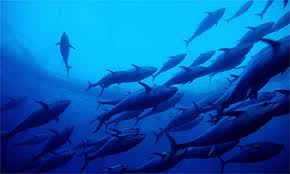The epipelic algal distribution of upper bonny estuary, AMADI-AMA creek, Niger delta in relation to sediment quality indices
Keywords:
Epipelic Algae, Estuary, Creek, Sediment parameters, Niger DeltaAbstract
The epipelic algal distribution in Amadi-Ama creek with respect to the sediment parameters were investigated from January 2009-December 2010(2years).Epipelic algal and sediment samples were collected from six sampling stations and analysed following standard limnological method of APHA. A total of 9709count/ml and 9584count/ml epipelic algae consisting of five(5) taxa and 79 species were identified in 2009 and 2010 respectively(Table1).Epipelic algal abundance followed the order: Bacillariophyceae > Cyanophyceae > Chlorophyceae >Euglenophyceae> Chrysophyceae. Spatially, the highest abundance of epipelic algae was recorded in station 3 in 2009 (2189count/ml) and 2010 (2262count/ml) representing 22.55% and 22.96% respectively. The most dominant species of epipelic algae observed was Cyclotella operculata. Apart from temperature, other sediment parameters such as pH, conductivity, nitrate, sulphate, phosphate and chlorophyll‘a’ exhibited spatial difference significantly (p<0.05). The high phosphate levels above the USEPA permissible limit in natural aquatic bodies indicate organic pollution. The observed chlorophyll‘a’ level in this study placed Amadi-Ama creek between mesotrophic and euthrophic level of productivity.References
American Public Health Association (APHA), 1998. Standard methods for the examination of water and
wastewater. 20th (ed) Washington DC 1213pp.
Boyd, C.E., 1981. Water quality in warm water fish ponds. Auburn University Press,Alabama, USA. 59-71
Chindah, A.C., 1990.Ecological post impact study of Ebubu-Ochani oil spillage Shell Development Company Limited.
Chindah, A.C., Cordelia, S.O., 2003. Levels of Hydrocarbon and Heavy metals in sediment and decapods
crustaceans(Crab-Uca Tangeri) inthe Bonny/New Calabar Estuary, Niger Delta.Pol.Journal of Environmental
Protection, 25/26,55-71.
Chindah, A.C., 1998. The effects of industrial activities on the periphyton community of upper New Calabar River,
Nigeria.Water Res.32(4),1137-1143.
Chindah, A.C., Hart, A.I., Uzoma, A.I., 1999. Periphyton associated with submerged macrophytes(Crinium natans) in
the Upper reaches of the New Calabar River, Niger Delta. J of Agric.Biotec.&Environment.1(2), 37-46.
Chindah, A.C., Braide, S.A., Oranye, R.O., 2004.Response of a common Niger Delta wetland Catfish to changes in
pH. Niger Delta Biologia 4(2),56-65.
Davies, O.A., Abowei, J.F.N., 2009. Sediment Quality of Lower Reaches of Okpoka Creek, Niger Delta, Nigeria
Douterelo, I., Perona, E., Meteo, P., 2004. Use of cyanobacteria to assess water quality in running waters. Elsevier
Environ. Pollut. 127, pp 377 – 884.
Frankovich, T.A., Gaiser, E.E., Zieman, J.C., Wachinicka A.H., 2006. Spatial and temporal distributions of epipelytic
diatoms growing on Thalassia testudinum banks exkong relationships to water. Hydrobiogia567,259 – 271.
Guy, D., 1992. The ecology of the fish pond ecosystem with special reference to Africa. 124- 130Pergamon press
– 230pp.
Guzkowska, M.A.J., Gasse, F., 1990. Diatoms indicators of water in some English urban lakes. Fresh Water biology
, 233 – 250.
Izuafuo, W.A.I., Chindah, A.C., Braide, S.A., Iyalla, I.A., 2004. An assessment of sediment quality at the vicinity of
marine landing jetties at the middle reach of Bonny Estuary, Niger Delta. Scientia Africana 3(2), 1- 10.
Lowkman, K., Jones, I.R., 1999. Nutrient sestomi chlorophyll relationship in Northern Ozark Resrvoir, Canada.
Journal of Fish and Aquatic Science 56,
Mucha A.P., Vasconcelos, M.T.S.D., Bordalo, A.A., 2003. Macrobenthic community in the Douuro Estuary in
relation with trace metals and natural sediment characteristics. Environmental pollution, 121,169-180.
Poulickova, A., Lysakova, M., Hasler, P., Lelkova, E., 2008c.Fish pond sediments-the source of palaeoecological
information and algal seed banks. “-Nova Hedwigia 86,141-153.
Statistical analysis system (SAS)., 2003. Statistical analysis system. User’s Guide SAS/STA-t version, 8th edition, SAS,
Institute, Inc. Cary, N. C., USA.
Tiseer, F.A.Y.T., Chia, A.M., 2008.Seasonal Occurrence of algae and physicochemical parameters ofSamaru
stream, Zaria, Nigeria.Asian J. Earth Sci., 1,31-37
United state environmental protection Agency (USEPA), 2002. Methods for evaluating wetland conditions: using
algae to assessenvironmental conditions in wetlands. Office of water, U.S. Environmental Protection Agency,
Washington D.C EPA – 822 – R – 02 – 021.

Downloads
Published
How to Cite
Issue
Section
License
Copyright (c) 2013 B. B. Otene, O. A. Davies

This work is licensed under a Creative Commons Attribution-NonCommercial-NoDerivatives 4.0 International License.



